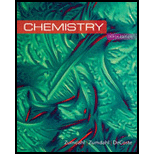
Bundle: Chemistry, Loose-leaf Version, 10th + Enhanced Webassign Printed Access Card For Chemistry, Multi-term Courses
10th Edition
ISBN: 9781337761642
Author: ZUMDAHL
Publisher: Cengage Learning
expand_more
expand_more
format_list_bulleted
Concept explainers
Question
Chapter 19, Problem 45E
Interpretation Introduction
Interpretation: A rock containing
Assuming no lead was originally present, and all the
Concept introduction: A process through which an unstable nuclide loses its energy due to excess of protons or neutrons is known as radioactive decay.
To determine: The age of the rock.
Expert Solution & Answer
Trending nowThis is a popular solution!

Students have asked these similar questions
>
You are trying to decide if there is a single reagent you can add that will make the following synthesis possible without any other
major side products:
1. ☑
CI
2. H3O+
O
Draw the missing reagent X you think will make this synthesis work in the drawing area below.
If there is no reagent that will make your desired product in good yield or without complications, just check the box under the
drawing area and leave it blank.
Click and drag to start drawing a
structure.
Explanation
Check
?
DO
18
Ar
B
© 2025 McGraw Hill LLC. All Rights Reserved. Terms of Use | Privacy Center | Accessibility
Don't use ai to answer I will report you answer
Consider a solution of 0.00304 moles of 4-nitrobenzoic acid (pKa = 3.442) dissolved in 25 mL water and titrated with 0.0991 M NaOH. Calculate the pH at the equivalence point
Chapter 19 Solutions
Bundle: Chemistry, Loose-leaf Version, 10th + Enhanced Webassign Printed Access Card For Chemistry, Multi-term Courses
Ch. 19 - Prob. 1RQCh. 19 - Prob. 2RQCh. 19 - Prob. 3RQCh. 19 - Prob. 4RQCh. 19 - Prob. 5RQCh. 19 - Prob. 6RQCh. 19 - Prob. 7RQCh. 19 - Prob. 8RQCh. 19 - Prob. 9RQCh. 19 - Prob. 10RQ
Ch. 19 - Prob. 1QCh. 19 - Prob. 3QCh. 19 - Prob. 4QCh. 19 - Prob. 5QCh. 19 - Prob. 6QCh. 19 - Prob. 7QCh. 19 - Prob. 8QCh. 19 - Prob. 9QCh. 19 - Prob. 10QCh. 19 - Prob. 11QCh. 19 - Prob. 12QCh. 19 - Prob. 13QCh. 19 - Prob. 14QCh. 19 - Prob. 15ECh. 19 - Prob. 16ECh. 19 - Prob. 17ECh. 19 - Prob. 18ECh. 19 - Prob. 19ECh. 19 - Prob. 20ECh. 19 - Prob. 21ECh. 19 - Prob. 22ECh. 19 - Prob. 23ECh. 19 - Prob. 24ECh. 19 - Prob. 27ECh. 19 - Prob. 28ECh. 19 - Prob. 29ECh. 19 - Prob. 30ECh. 19 - Prob. 32ECh. 19 - Prob. 34ECh. 19 - Prob. 35ECh. 19 - Prob. 36ECh. 19 - Prob. 37ECh. 19 - Prob. 38ECh. 19 - Prob. 39ECh. 19 - Prob. 40ECh. 19 - Prob. 41ECh. 19 - Prob. 42ECh. 19 - Prob. 43ECh. 19 - Prob. 44ECh. 19 - Prob. 45ECh. 19 - Prob. 46ECh. 19 - Prob. 47ECh. 19 - Prob. 48ECh. 19 - Prob. 49ECh. 19 - Prob. 50ECh. 19 - Prob. 52ECh. 19 - Prob. 53ECh. 19 - Prob. 54ECh. 19 - Prob. 55ECh. 19 - Prob. 56ECh. 19 - Prob. 57ECh. 19 - Prob. 58ECh. 19 - Prob. 59ECh. 19 - Prob. 60ECh. 19 - Prob. 61ECh. 19 - Prob. 62ECh. 19 - Prob. 63ECh. 19 - Prob. 64ECh. 19 - Prob. 65AECh. 19 - Prob. 66AECh. 19 - Prob. 67AECh. 19 - Prob. 68AECh. 19 - Prob. 69AECh. 19 - Prob. 70AECh. 19 - Prob. 71AECh. 19 - Prob. 72AECh. 19 - Prob. 73AECh. 19 - Prob. 74AECh. 19 - Prob. 75AECh. 19 - Prob. 76AECh. 19 - Prob. 77AECh. 19 - Prob. 78AECh. 19 - Prob. 79AECh. 19 - Prob. 80AECh. 19 - Prob. 81CWPCh. 19 - Prob. 82CWPCh. 19 - Prob. 83CWPCh. 19 - Prob. 84CWPCh. 19 - Prob. 85CWPCh. 19 - Prob. 86CWPCh. 19 - Prob. 87CPCh. 19 - Prob. 88CPCh. 19 - Prob. 89CPCh. 19 - Prob. 90CPCh. 19 - Prob. 91CPCh. 19 - Prob. 92CPCh. 19 - Prob. 93CPCh. 19 - Prob. 94CPCh. 19 - Prob. 95IPCh. 19 - Prob. 96IP
Knowledge Booster
Learn more about
Need a deep-dive on the concept behind this application? Look no further. Learn more about this topic, chemistry and related others by exploring similar questions and additional content below.Similar questions
- What is the name of the following compound? SiMe3arrow_forwardK Draw the starting structure that would lead to the major product shown under the provided conditions. Drawing 1. NaNH2 2. PhCH2Br 4 57°F Sunny Q Searcharrow_forward7 Draw the starting alkyl bromide that would produce this alkyne under these conditions. F Drawing 1. NaNH2, A 2. H3O+ £ 4 Temps to rise Tomorrow Q Search H2arrow_forward
arrow_back_ios
SEE MORE QUESTIONS
arrow_forward_ios
Recommended textbooks for you
 ChemistryChemistryISBN:9781305957404Author:Steven S. Zumdahl, Susan A. Zumdahl, Donald J. DeCostePublisher:Cengage Learning
ChemistryChemistryISBN:9781305957404Author:Steven S. Zumdahl, Susan A. Zumdahl, Donald J. DeCostePublisher:Cengage Learning Chemistry: An Atoms First ApproachChemistryISBN:9781305079243Author:Steven S. Zumdahl, Susan A. ZumdahlPublisher:Cengage Learning
Chemistry: An Atoms First ApproachChemistryISBN:9781305079243Author:Steven S. Zumdahl, Susan A. ZumdahlPublisher:Cengage Learning
 Chemistry for Engineering StudentsChemistryISBN:9781337398909Author:Lawrence S. Brown, Tom HolmePublisher:Cengage Learning
Chemistry for Engineering StudentsChemistryISBN:9781337398909Author:Lawrence S. Brown, Tom HolmePublisher:Cengage Learning Chemistry & Chemical ReactivityChemistryISBN:9781337399074Author:John C. Kotz, Paul M. Treichel, John Townsend, David TreichelPublisher:Cengage Learning
Chemistry & Chemical ReactivityChemistryISBN:9781337399074Author:John C. Kotz, Paul M. Treichel, John Townsend, David TreichelPublisher:Cengage Learning


Chemistry
Chemistry
ISBN:9781305957404
Author:Steven S. Zumdahl, Susan A. Zumdahl, Donald J. DeCoste
Publisher:Cengage Learning

Chemistry: An Atoms First Approach
Chemistry
ISBN:9781305079243
Author:Steven S. Zumdahl, Susan A. Zumdahl
Publisher:Cengage Learning


Chemistry for Engineering Students
Chemistry
ISBN:9781337398909
Author:Lawrence S. Brown, Tom Holme
Publisher:Cengage Learning

Chemistry & Chemical Reactivity
Chemistry
ISBN:9781337399074
Author:John C. Kotz, Paul M. Treichel, John Townsend, David Treichel
Publisher:Cengage Learning